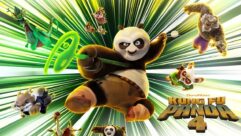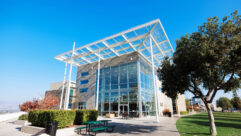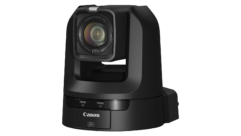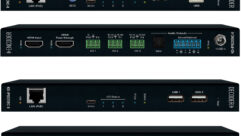The efficiency and creative uses of a classic movie-animation technique have been greatly improved of late due in large part to the advanced features, compact size, and high-resolution still-photo capabilities of EOS 5D Mark II SLR cameras from Canon U.S.A., Inc., a leader in digital imaging solutions. The technique, known as stop-motion animation, is distinctive in appearance but traditionally labor-intensive, entailing frame-by-frame photography of a puppet “actor” to create the illusion of movement. LAIKA, the renowned animation studio near Portland Ore., has recently streamlined the photography and workflow of its latest stop-motion 3D feature film, ParaNorman, using 60 Canon EOS 5D Mark II cameras and other advanced digital technologies.
“It took us 86 weeks to shoot the principal photography,” noted John Ashlee Prat, one of five lighting cameramen on the film. “The Canon 5D Mark II has features that helped us to expedite this process.” A horror comedy about a small-town boy who can see and speak to spirits, ParaNorman’s eponymous hero must battle an assortment of ghosts, witches, zombies, and terrified humans to save his town from doom. In order to capture the more than 400,000 separate stop-frames needed to create ParaNorman, the film was divided among five camera teams and 50 separate units at LAIKA’s 151,000 square ft. studio. Each unit had its own shooting stage, sets, puppet “actors,” equipment (including Canon EOS 5D Mark II cameras), and a crew working on different portions of the film simultaneously. Director of Photography Tristan Oliver supervised the entire production. Of all the film-resolution digital still cameras on the market, Prat explained, the 5D Mark II had the best combination of features needed for the 3D stop-motion animation of ParaNorman.
“Stop-motion animators need a live-view reference to see and record their progress,” he said. “We tested every off-the-shelf digital SLR camera that can provide live view and the high-resolution RAW image files we needed, and we found that the Canon 5D Mark II live view is far superior to any of the others. The 5D Mark II also provides the RAW image output we needed, and a USB connector to feed files to our in-house network.”
Production Workflow
Compact, lightweight, and compatible with Canon’s wide selection of EF Series lenses, the 5D Mark II digital SLR camera is equipped with a 21.1 megapixel full-frame Canon CMOS sensor and DIGIC 4 image processor for exceptional still-image capture in a number of RAW or JPEG modes and sRAW options. (The 5D Mark II can also record exceptional full 1920 x 1080 HD motion imagery, which wasn’t needed for ParaNorman’s stop-motion still-photo technique.)
Although the Canon 5D Mark II is designed to record to CF media cards, LAIKA instead used the USB output of each camera to feed all image data directly to computers running Dragonframe stop-motion animation software. Dragonframe recorded each image in the resolutions needed to a server farm, and enabled animators to review their work at any time by shuttling footage back and forth on a special keypad.
“Dragonframe ingests a full .CR2 Canon RAW format file for each frame along with a JPEG, which can be played back for animator reference,” Prat explained. “The RAW files and JPEGs get exported out as a neat little package to editorial for smooth postproduction workflow. Later on we resized and worked in 2K, but still had the hi-res RAW files to fall back on when we needed to do special effects on specific shots.”
Creative Advantages
Photography of a stereoscopic 3D film requires the capture of not one, but two frames – a left and a right image – 24 times for every second of screen time (in stop-motion animation that number is doubled to 48). The compact size of the Canon 5D Mark II digital SLR camera (as opposed to traditional film cameras) greatly facilitated the capture of the corresponding left- and right images needed for 3D, especially given the miniature sets and puppets being photographed. Each 5D Mark II camera was mounted on a computer-controlled motorized horizontal slider, which moved the camera first right and then left for sequential capture of all the necessary 3D frame-pairs.
“The slider is necessary because we can’t put two cameras side-by-side to successfully photograph little 8- to 12-inch puppets in a miniature world,” Prat explained. “We have to use the inter-ocular distances appropriate to that world in order for it not to look miniature. Depending on the shot, those distances can vary from as little as half a millimeter to maybe 10 or 12 millimeters. That’s why the 5D Mark II on a slider works so well. In addition, the compact SLR form factor added stability to our motion-control rigs and allowed us to design smaller-profile rigs that allowed us to put cameras in interesting places – in tunnels and in low-angle situations – that increased our ability to create interesting shots. Another reason why the 5D Mark II is well-suited for stop-motion animation is because it captures images directly through its lens, without parallax. What the animator sees is exactly what he’s going to get, which is crucial for any kind of filmmaking.”
Time-Saver
Ruggedly built, the Canon 5D Mark II integrates many advanced technologies designed for convenient operation. Among these is a self-cleaning sensor unit, which employs a low-pass filter at the front of the sensor to automatically shake off dust with ultrasonic vibrations. The EOS 5D Mark II also has a coating on the front surface of the low-pass filter to increase its resistance to dust sticking to the sensor.
“The self-cleaning sensor feature of the Canon 5D Mark II saved us a lot of time because we didn’t need to take the lens off to clean the sensor,” Prat added. “Also, after principal photography we checked all the 5D Mark II cameras for their total number of shutter actuations, and some of them got up to 150,000. We are rolling our current fleet of Canon 5D Mark II cameras on to our next production, although not for principal photography. Instead they will be used to support all the other departments for their photographic needs. We expect they will make it through the next production with little problem. Principal photography will be done with
Canon 5D Mark III cameras, which feature a noise level that’s two stops better than the original Mark IIs, and that’s even better for us.”
Although the comical characters in ParaNorman experience many frightening adventures, LAIKA’s use of Canon 5D Mark II cameras provided no unpleasant surprises. “The Canon 5D Mark II performed beautifully,” Prat concluded. “We were able to shoot the whole movie without having any cameras fail on us, which was wonderful. This gives me confidence in our decision to use the 5D Mark III on the next production. Canon has made a commitment to the cinema world, and they listen to users to learn how they can improve their products. They stopped by LAIKA to see how we do things, which we really appreciate.”
###










